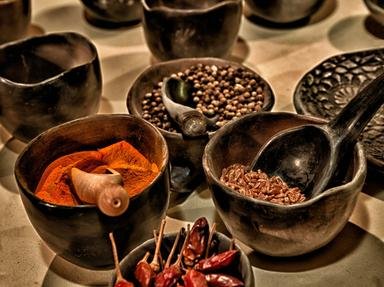Quiz Answer Key and Fun Facts
1. The esteemed professor straps me into the machine and assures me that all will be well before putting on a helmet and standing behind a protective barrier. Before I have a chance to sign a waiver, he throws the switch and I immediately smell an aroma familiar from a number of teas, jellies, and mojitos. What herb am I likely experiencing?
2. I feel nauseous as I look up to discover that the laboratory has disappeared. While I'm still strapped into the chair I can see a forest of laurel trees. I can smell the bark from where I sit and it reminds me of spicy candy hearts and apple pie. What spice is likely the cause?
3. The contraption shudders and shakes and soon I'm whisked away to another part of the world. The machine comes to a rest in India in a grove of green plants. This particular herb, I recall, is one of the main ingredients in Italian pesto. What must be planted nearby?
4. I close my eyes as my seat moves to another time and place and before I know it, I've arrived. With my eyes still closed, I can smell the next spice and remember it's commonly used in a very specific bread and also in a specific type of ale. Which of these names fits the bill?
5. The next time the Thyme Machine begins its motions I've been placed in a warm field of green herbs. Although they look delectable growing at my sides, I know that these are likely to be dried out and used in an Italian pizza or to season fish. What often bitter herb is this?
6. Another hop, skip, and jump in the Professor's infernal machine takes me to a forest of pods in Madagascar. Picking an opening pod off a tree, I realize that the bean inside is actually a rather famous spice used in ice cream and chocolate (though I'm not holding a cacao bean)! What spice, often used in baking, is it?
7. I lurch ahead and find myself overlooking a cucumber patch. Amongst these vegetables, I notice sprigs of thin herbs commonly used as herbs though their seeds are commonly used as spices. What substance am I overlooking here under the bright sun?
8. Uh oh. The machine has landed in trouble this time- it's squashed a number of these beautiful purple flowers. That'll cost us! It's actually the red threads of this flower that are used in cooking. What is the name of this spice?
9. Another rattling motion and another swirl through time and space brings me to an Italian grove to find this green herb. Sniffing the plants around me, I smell a pleasing aroma. What is this herb known for its medicinal uses and its typical purpose as a garnish?
10. The chair shifts and rocks as I'm finally transported back to the Professor's laboratory. While he removes the straps from my body I notice that I'm clutching one final herb from my trip. This particular specimen, although good with lamb and stews, is also an ingredient in most antiseptics and mouthwash. I must have a sprig of which herb?
Source: Author
kyleisalive
This quiz was reviewed by FunTrivia editor
WesleyCrusher before going online.
Any errors found in FunTrivia content are routinely corrected through our feedback system.

